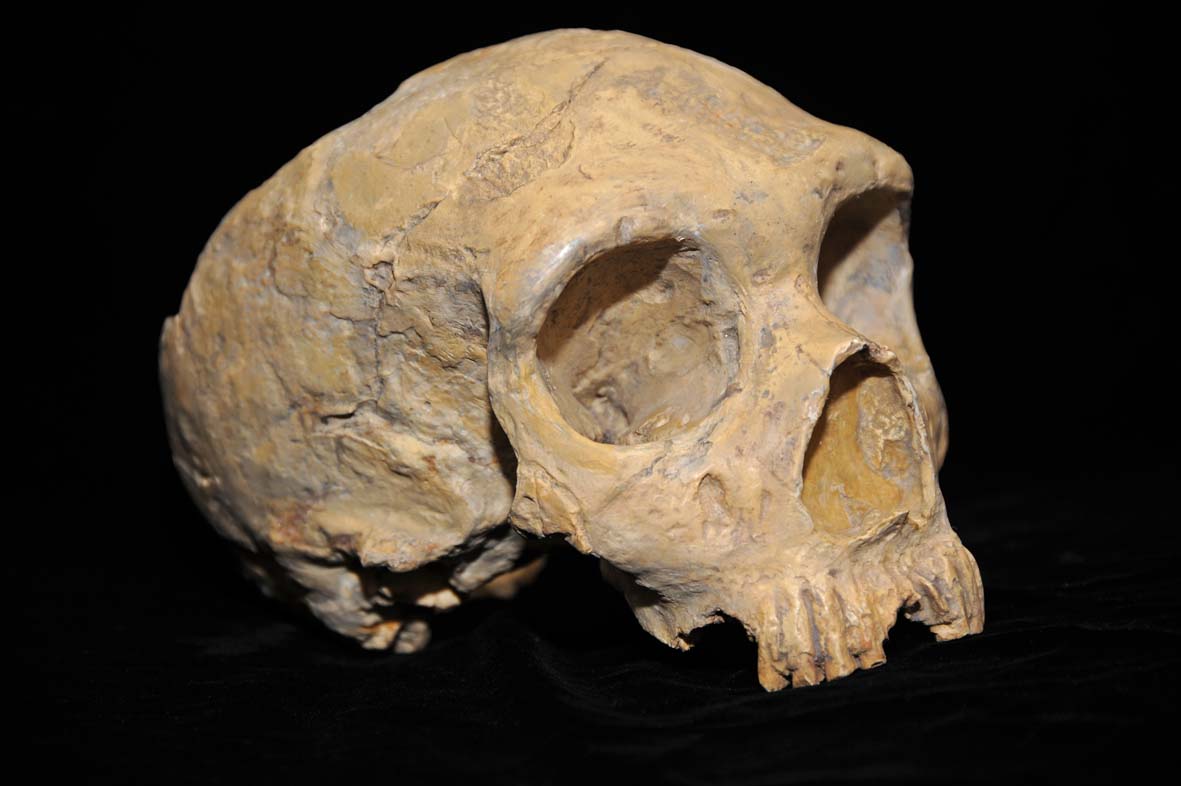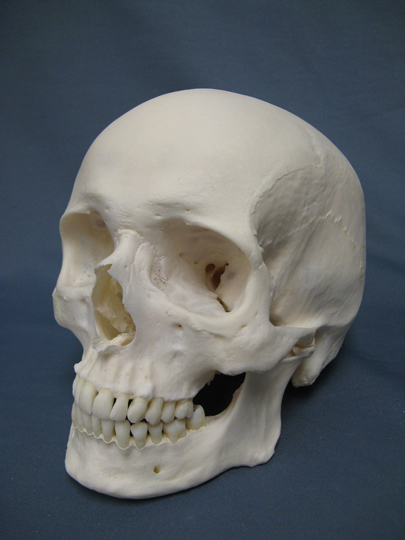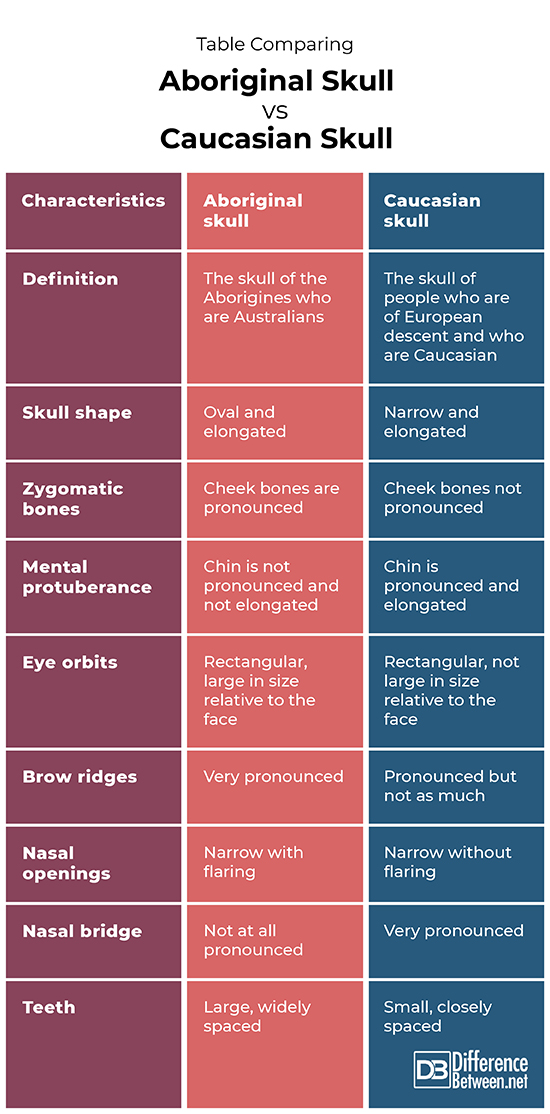Difference Between Aboriginal Skull and Caucasian Skull
An Aboriginal skull is the skull that is found in people who are Australian Aborigines. A Caucasian skull is the skull that is found in people who are European.

What is Aboriginal Skull?
Definition:
An Aboriginal skull is a type of skull that is found among the Aboriginal people that live in Australia.
Features of the cranium and chin:
The skull of Aborigines is typically elongated and has an oval shape when viewed from the front side. The depression on the temporal bone, known as the temporal fossa, is not well filled in these types of skulls, although it is more so in women than in men. There is often a post-orbital constriction evident on the skull. The most posterior bone of the skull, the occipital is pronounced into a bulge. The zygomatic bones (cheekbones) are more evident and pronounced and there is less of a chin compared with the European Caucasian skulls.
Features of the eye orbits and brow:
The eye orbits of this skull type are large relative to the face and considered to be angular. The ridges of the brows are very large and pronounced in the Aboriginal skull, particularly in male individuals.
Features of the nasal region:
The nasal openings of the Aboriginal skull are quite narrow compared with some other races but they do show a flaring with the top part being much narrow than the bottom part of the nose. The nose doesn’t really have a noticeable tip to it in the way that Caucasoids have. It has been described as having a convex ellipsoid-type of shape instead. The lower region of the nose is much wider than is seen when you compare it to the nose of Caucasians. The bridge of the nose is also very flat and not pronounced at all in the way it is in Caucasians.
Features of the jaw and teeth:
Historically, the loss of bone in the alveolar region of the jaw has been found to be greater in skulls of Aboriginal people compared with that found in people with Caucasian skulls. The teeth are also bigger in size and more widely spaced in Aborigines.

What is Caucasian skull?
Definition:
A Caucasian skull is a skull that is found in people who are of European descent and are Caucasian.
Features of the cranium and chin:
The skull shape of a Caucasoid person is generally long and it is narrow when compared to the skull shape that is evident in other race groups of people. The zygomatic bones are less pronounced in Caucasians compared with other ethnic groups of people, and the chins (mental protuberance) are more pronounced in the skulls of European people.
Features of the eye orbits and brow:
In Caucasoids, the eye orbits are rectangular in shape but less massive compared with the overall size of the face when compared with Australoid skulls (Aborigines), and eye orbits do appear sloped in European skulls. Caucasian people also have eye orbits that seem to be sloped when seen from the anterior viewpoint. The brow ridges are also less pronounced when compared with the Aboriginal skull ridges but more pronounced than some other races.
Features of the nasal region:
The skulls of Caucasian people tend to have a more triangle shape to the opening of the nose compared with the nasal openings seen in the skulls of the other race groups. In addition, European skulls show a more protruding and obvious nasal ridge, and the nose is not flared.
Features of the jaw and teeth:
Loss of bone in the alveolar region of the jaw has been found to be less pronounced in the skulls of Caucasoid when compared with that which has been seen historically in the skulls of Negroid and Australoid skulls. The amount of alveolar loss was also noted to decrease by the 19th century. Teeth are small in size and are arranged closely together in the Caucasoid type of skull. This is different from the other racial groups in which teeth are seen to be much larger in size with teeth spaced further apart by comparison.
Difference between Aboriginal skull vs. Caucasian skull?
-
Definition
The Aboriginal skull is the skull type of the Australian Aborigines. The Caucasian skull is the type of skull found in Europeans who are Caucasian.
-
Skull shape
The shape of the aborigine skull is oval and elongated. The shape of the Caucasian skull is narrow and elongated.
-
Zygomatic bones
The cheek bones of the Aborigines are very pronounced. The cheek bones of the Caucasians are not as pronounced.
-
Mental protuberance
The chin area of the skull is not pronounced in Aborigines. The chin area of the skull is pronounced and elongated in Caucasians.
-
Eye orbits
The eye orbits of the Aboriginal skull are rectangular and large compared to the size of the face. The eye orbits of the Caucasian skull are rectangular but are not as big relative to the size of the face.
-
Brow ridges
The brow ridges are very pronounced in the Aboriginal skull. The brow ridges are less pronounced in the Caucasian skull.
-
Nasal openings
Aboriginal skulls typically have narrow nasal openings but the nose is flared. Caucasian skulls also have narrow nasal openings but the nose is not flared.
-
Nasal bridge
The nasal bridge is very flat and not pronounced in Aborigines. The nasal bridge is very pronounced in Caucasians.
-
Teeth
The teeth of Aborigines are large in size and widely spaced. The teeth of Caucasians are small in size and closely spaced.
Table Comparing Aboriginal Skull vs. Caucasian Skull

Summary of Aboriginal Skull vs. Caucasian Skull
- Aboriginal skulls are an oval and elongated shape.
- Caucasian skulls are narrow and long.
- Aborigines have skulls that show prominent brow ridges and flared noses.
- Caucasoids have skulls that show less prominent brow ridges and noses that are not flared.
- Both Aborigines and Caucasians have rectangular eye orbits but they tend to be smaller in size in Caucasoids.
- Difference Between Rumination and Regurgitation - June 13, 2024
- Difference Between Pyelectasis and Hydronephrosis - June 4, 2024
- Difference Between Cellulitis and Erysipelas - June 1, 2024
Search DifferenceBetween.net :
2 Comments
Leave a Response
References :
[0]Image credit: https://en.wikipedia.org/wiki/Neanderthals_in_Gibraltar#/media/File:Neanderthal_skull_from_Forbes'_Quarry.jpg
[1]Image credit: https://en.m.wikipedia.org/wiki/File:Caucasian_Human_Skull.jpg
[2]Freedman, Leonard, and M. Lofgren. "The Cossack skull and a dihybrid origin of the Australian Aborigines." Nature 282.5736 (1979): 298.
[3]Lavelle, C. L. B. "Alveolar bone loss and tooth attrition in skulls from different population samples." Journal of periodontal research 8.6 (1973): 395-399.
[4]Tsunoda, Atsunobu. "Arcuate eminence in Caucasian populations." The Journal of Laryngology & Otology 115.1 (2001): 9-13.

Thank you for telling us the truth.
This does not take into account that these are AVERAGE differences in skull shape. The human genome shows that race is indeed a man-made construct